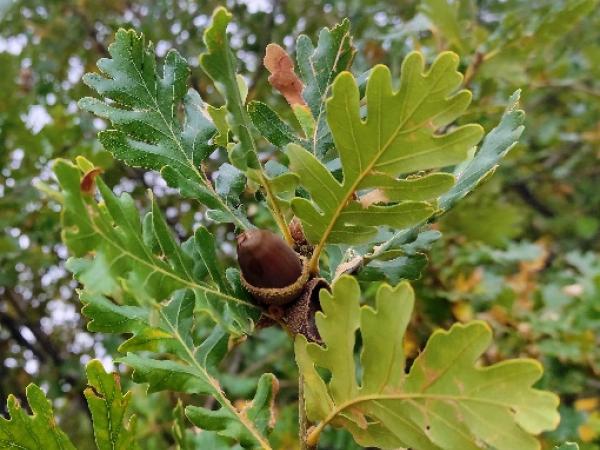Editor's Picks
Plant Focus
 |
| Oaks with girths larger than 7 m are mapped on Rainer Lippert's website, with icons colored according to size (from pale yellow to dark red) |
Rainer Lippert has always been interested in old trees. At the age of 16 he started to visit the largest trees in his home district in Germany, drawn in particular to the majestic grandeur of ancient oaks. He recorded their dimensions, categorizing the giants according to the girth of their trunks. As he grew older, his range of action became wider, expanding from rural district to administrative region, then his entire native Bundesland (as German states are called), and ultimately all of Germany.
He developed this hobby for almost 30 years. About 10 years ago, he started writing Wikipedia articles about special trees. But it was old oaks that most fascinated him, and in 2013 he decided to develop his own site where he could publish his records of the giants he had visited and documented. “During the first two years progress was very slow,” says Rainer, “mainly because I had no idea how to program a website. That’s why my site is so simple.”
 |
| The Breiteich (Broad Oak) at Gottwollshausen in Baden-Wurttemberg, 7 m girth © Rainer Lippert |
But Rainer’s website, Monumentale Eichen (Monumental Oaks) is far from simple: it is an astounding reference work that lists more than 600 ancient oaks all over Germany. Each tree is meticulously documented, naming the exact location, listing coordinates, altitude, species, estimated age, height, circumference, and crown spread. Beautiful photographs of the whole tree and several views of the trunk accompany each listing, as well as a detailed description.
The listings are grouped by Bundesland, and there are oaks recorded in all of Germany’s sixteen states and city states except for the Free Hanseatic City of Bremen. Another section of the website lists oaks that were originally reported by others; many of these trees have subsequently been documented by Rainer himself, hence they have two entries in the website. Other sections include notable oaks with girths under 6 m (Rainer’s cut off mark for the “monumental oak” definition), giant multi-stemmed oaks, non-native oaks, fastigiate oaks, historically significant oaks, and 264 notable trees of other genera.
 |
| The Big Oak at the Ivenack Zoo in Mecklenberug-Vorpommern, with the largest girth in Germany (11.7 m) © Rainer Lippert |
Additional features include texts discussing age estimations and measurement methods. Aside from the standard circumference at breast height (BHU in German, the abbreviation for Brusthöhenumfang), Rainer records the “waist circumference”, which does not depend on ground level and aims to measure the smallest diameter of the trunk up to a maximum height of 2.5 m. This method, which Rainer devised, makes it easier to repeat the measurement at a later date.[1] A detailed bibliography covering oaks in Germany can also be found on the website, as well as a special section dedicated to forest scientist and conservationist Hans Joachim Fröhlich (1923-2008), whose 12-volume Wege zu alten Bäumen (Paths to Old Trees) is described by Rainer as an “indispensable source.”
“In recent years I have visited all the important oak trees in Germany,” says Rainer. “I had visited many of them before, but I did not have digital photos of them. In the last 3 to 4 years I documented most of the large oaks, visiting over 600 oak trees with a circumference above 6 m. A typical tree tour lasts 3 to 5 days, always in a specific region of Germany.” Rainer would like to add more sections to the website, but it all takes time, and he can only devote his leisure time to the project.
In its present state, Momunentale Eichen is an impressive achievement, and a model reference work for anyone interested in giant oaks in Germany. It is clear that “monumental” describes not only the type of oak documented: it is also an apt description of the dimension of Rainer Lippert’s achievement.
The website is in German, but the translation provided by a standard web browser is more than adequate to read the content in English or the language of your choice: www.monumentale-eichen.de
[1] Rainer says he did not know how to measure a tree 30 years ago. “There was no internet at that time. And I did not have any books on this topic back then either. I thought about how best to measure the circumference of a tree. And then the waist measurement seemed to me to be the best. Since I'm quite tall (1.94 m), I can measure with the tape measure up to 2.5 m in height. And for 99% of the oaks, the waist is below 2.5 m. Even the oak with the widest trunk in Germany, the one at Ivenack, has its waist, i.e., the smallest stem circumference, at a height of 2.5 m. Only a few oaks, which grew up in the forest and have a long, straight trunk, have a waist located above 2.5 m. It was not until much later that I learned that conventionally one measures circumference at breast height, i.e., at a height of 1.3 m. The German Tree Archive in turn measures at a height of 1 m. Both measurement methods have a decisive disadvantage for me. If the oak stands on a slope, it is difficult to determine the correct measuring height. This inevitably means that in a later visit you do not measure at exactly the same height. Even if you measure several times in succession, you get different readings. With my measurement method, I always measure at the thinnest point. And this place is easy to determine even years later. If an oak stands on a slope, then you do not have to worry about the measuring height. If I measure the waist five times, I have almost exactly the same result five times; whereas with breast-height measurements, differences of more than ten centimeters may occur. Another point is that when the stem is highly irregular due to burls, bulges and so on, if you measure exactly at a certain height around the trunk, it is always difficult to decide which burl you include and which not. If one measures over a burl, that can influence the measurement result. Also in such a case a measurement is difficult to reproduce. Every time you get a different result. This is easier with the waist measurement. Meanwhile, I also measure at breast height and at 1 m, so that the measured values are comparable with the values in the literature and on other websites. But I still think my waist measurement is the most appropriate method. In the last five years, I have probably visited and measured around 5,000 trees in Germany. With the waist measurements, I always had the least problems."















